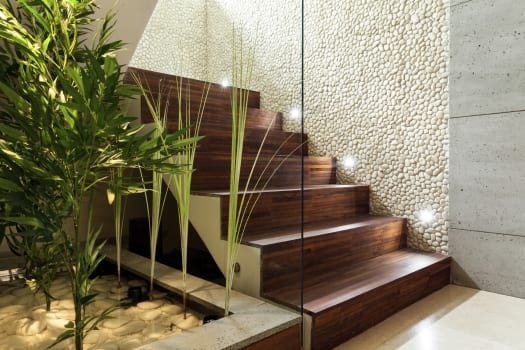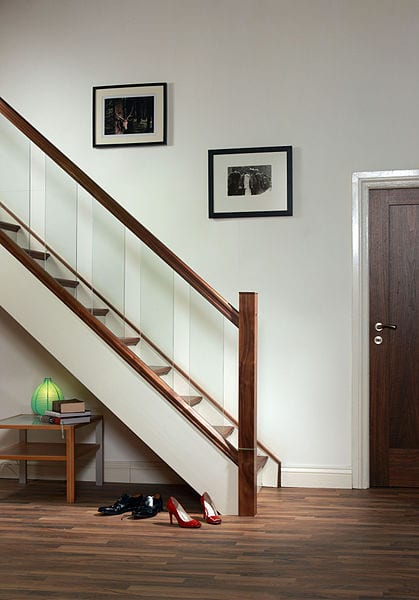Wood is the most commonly used material for a staircase and instantly provides a home with character and warmth. Many people therefore choose wooden stairs. What are the properties of a wooden staircase, what types are there and what should you pay attention to when choosing wood? You can read all about it in this article.
What does a wooden staircase cost?
The cost of a standard, straight wooden staircase averages around £ 800, excluding the cost of installing the staircase. The cost of a wooden staircase depends, among other things, on the following choices.
- Wood type
- Open or closed staircase
- Number of turns
- Finishing
The various choices can increase the price by up to £3,000. Check out the various options you have when buying a wooden staircase below.
| Type of wooden staircase | Cost per wooden staircase, incl. VAT, excl. installation | |
|---|---|---|
| Open fir staircase | Gem. £ 900 | |
| Closed fir staircase with bottom or top quarter | Gem. £ 1,250 | |
| Closed oak staircase with double quarter | Gem. £ 3.000 |
Find the best specialist for your project and get free quotes.
Start

The benefits of wooden stairs
Wooden stairs are so popular for a reason. There are plenty of reasons for this:
- Wood is generally easy to work with.
- Wood parts are easier to transport and work with than concrete or metal and weigh a lot less.
- Wood stair parts are available in numerous subtle colour tones.
- For a tailor-made staircase, a wooden staircase is often the best choice.
A wooden staircase can’t really be beat when it comes to price, user-friendliness and appearance either:
- The many types of wood available mean that you have plenty of choice. From oak, to beech or rubberwood, there is something for everyone.
- The natural look of wood is a well-known plus. Wood has a warm feel and by definition a unique structure.
- A wooden staircase is easy to adapt to your specific needs. Are you looking for a matt look? A satin sheen? Or may the staircase catch the eye with high gloss? All kinds of finishes are possible.
- A wooden staircase is particularly user-friendly. Just vacuum it or wipe it with a damp cloth and your staircase is ready to use again.
- Wooden staircases are available for any budget. A wooden staircase is usually much cheaper than one made of steel, concrete or even glass.
- Wood is a chameleon in terms of processing. Do you want a classic staircase, a contemporary or ultra-modern look? Should it be a straight staircase? Do you like a spiral staircase, a floating one or one with a nice landing? Anything is possible with wood.
- Eventual damage adds to the charm of a wooden staircase. Larger damages are easy to remove or repair.
- Wood is master of styling: it combines beautifully with harder materials such as concrete, glass or steel or softer materials like carpet.
The disadvantages of wooden stairs
Although the advantages of wooden stairs are many, there are also a number of disadvantages:
- If you choose very cheap wood, you will soon have ruts.
- Wood works and creaks. Annoying for people who like clean and quiet.
- Wood requires more maintenance than concrete or metal. Varnishing or repainting every few years is definitely part of the job.
- With a newly built house, you don’t get a good impression of your staircase until late in the construction phase. This is because, unlike a concrete staircase, a wooden staircase can only be installed at a late stage.
Features of a wooden staircase
You know your (upcoming) home and your wishes for your ideal design best. We are happy to help you make an informed choice for your wooden staircase. If you want to have a wooden staircase installed, there are a number of points of interest that are important when buying and maintaining the staircase. We would like to inform you about the main feature of this popular material for steps.

Maintenance of a wooden staircase
Wood is a living material. Therefore, it generally needs just a little more maintenance than a concrete or metal staircase. It is not at all a bad thing if your wooden staircase shows signs of use. That’s part of its charm. But if you want to enjoy your wooden staircase for a long time, give it a new coat of paint every three years. Have you treated your wooden staircase with specially developed varnish for stairs? Then you can go on for at least 20 years. And of course, if you walk barefoot or with slippers, your wooden staircase will wear less quickly.
Noise from wooden staircases
Wood is a natural product and you will hear it. A wooden staircase can creak as soon as you step on it or ‘work’ a bit in hot or, on the contrary, cold weather with accompanying soft creaks. Especially closed staircases and older construction methods creak a little more. On the other hand, wooden stairs have a nice acoustic insulation value. The footsteps on a wooden staircase sound much softer and more homely than on a metal or concrete one.
Damage and repairs
Wood is more fragile than metal or concrete and is more likely to show slight damage. Nevertheless, damage does not affect a wooden staircase as much as a metal or concrete one. Due to the structure of the natural material with its many grains and slight colour differences, small damages or pits are not at all noticeable. Wood actually becomes more beautiful with age. It literally lives and molds to its users. Is there any major, ugly damage? Then you can easily have the spot filled and re-coloured, restoring your staircase to its former glory. In old, neglected houses, replacing the wooden staircase is often cheaper than a full staircase renovation.
Finishing materials of wooden stairs
A wooden staircase is usually treated with varnish, stain or paint. Only wood of (durability) class I can be left untreated. The signs of use on such a staircase do not need to be repaired. They only add to the special character of an authentic wooden staircase.
A staircase made of durable wood
And then, of course, there is the option of choosing a staircase made of durable wood. Do you choose a staircase made of wood with a FSC label or a PEFC label? These labels guarantee that your wooden staircase has a sustainable and responsible origin. This is because both FSC wood and PEFC-certified wood come from a sustainably managed forest. Or even better, it has been recycled.
There are three types of FSC labels:
- FSC 100%: the wood product comes 100% from forests that are FSC-certified.
- FSC mix: the wood product consists of a mix of recycled material. At least 70% must be FSC material to comply with this label.
- FSC recycled: the wood product is produced entirely from recycled material.
PEFC uses two labels:
- PEFC certified: the wood product originates 70% to 99% from recycled material and/or certified forest and the remainder from controlled, legal harvesting.
- PEFC recycled: the wood product consists of 100% PEFC-certified raw material from recycled sources.
FSC and PEFC are sustainability labels with strict requirements and are recognised worldwide. FSC is also a sustainability label with the support of environmental organisations such as Greenpeace and WWF.
With a wooden staircase made of sustainable wood, you not only get a beautiful product in your home; you also help to protect the forests and reduce your ecological footprint.
Find the best specialist for your project and receive free quotes.
Start